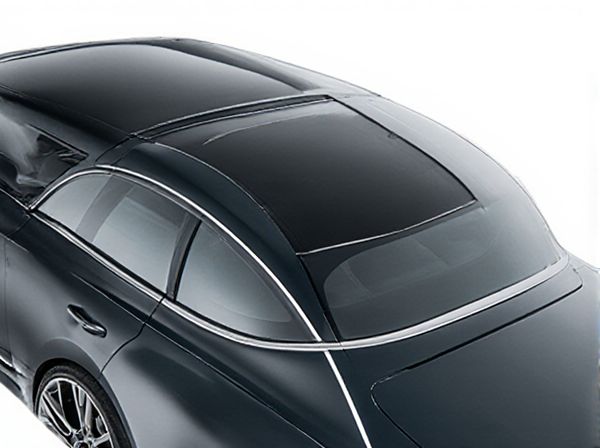
Photo illustration: Fastback Roof vs Notchback Roof
A Fastback roof features a continuous, smooth slope from the roofline to the rear, enhancing aerodynamics and giving vehicles a sporty, streamlined appearance. A Notchback roof, on the other hand, has a distinct angle between the roof and the rear deck, creating a defined trunk area and a more traditional silhouette. Understanding these differences helps you choose a design that matches your style preference and performance needs.
Table of Comparison
| Feature | Fastback Roof | Notchback Roof |
|---|---|---|
| Design | Smooth, continuous slope from roof to rear | Distinct separation between roof, rear window, and trunk |
| Aerodynamics | Improved airflow, reduced drag | Higher drag due to abrupt rear end |
| Rear Headroom | Less rear passenger headroom | More rear passenger headroom |
| Trunk Space | Smaller trunk volume | Larger trunk volume |
| Styling | Sporty, modern appearance | Classic, traditional look |
| Popular Models | Ford Mustang Fastback, Audi A5 Sportback | BMW 3 Series Sedan, Mercedes-Benz C-Class Sedan |
Introduction to Car Roof Styles
Fastback roofs feature a continuous slope from the roof to the rear end, creating a sleek, aerodynamic profile commonly seen in sports cars and muscle cars. Notchback roofs have a distinct break between the roof and the trunk, forming a three-box design typical of sedans and classic automobiles. These differing roof styles impact vehicle aesthetics, aerodynamics, and cargo space.
Defining Fastback Roof Design
The Fastback roof design features a continuous, smooth slope from the roof to the rear end, creating a streamlined, aerodynamic profile that enhances vehicle performance and aesthetics. Unlike the Notchback roof, which has a distinct, angular separation between the roof and trunk area, the Fastback's seamless curve improves airflow efficiency and reduces drag. This design is commonly seen in sports cars and muscle cars, emphasizing speed and style.
Understanding Notchback Roof Design
Notchback roof design features a distinct, angular break between the roof and trunk, creating a separate rear window and trunk area, which enhances rear visibility and trunk space. Unlike the continuous slope of a fastback roof, the notchback's defined roofline improves aerodynamics and structural rigidity while maintaining classic sedan proportions. This design is common in traditional sedans and offers a balance between style, functionality, and comfort.
Key Visual Differences: Fastback vs Notchback
The Fastback roof design features a continuous, smooth slope from the roofline to the rear of the car, creating a streamlined silhouette that enhances aerodynamics and sporty aesthetics. In contrast, the Notchback roof has a distinct, angular break between the roof and the trunk, resulting in a three-box profile with separate roof, cabin, and trunk sections. Key visual differences include the Fastback's flowing rear window and rear end integration versus the Notchback's pronounced rear window angle and clear separation between roof and trunk.
Aerodynamics: Performance Impacts
Fastback roofs provide a smooth, continuous slope from the roof to the rear, minimizing air resistance and improving aerodynamic efficiency, which enhances vehicle stability and fuel economy at high speeds. Notchback roofs, with their angular rear window and distinct trunk area, create more turbulence and drag, resulting in slightly reduced aerodynamic performance. The streamlined design of fastback roofs makes them preferable for performance vehicles seeking better airflow and reduced drag coefficients.
Interior Space and Comfort Comparison
Fastback roofs offer a sleek, continuous slope that often reduces rear headroom but enhances aerodynamic efficiency, resulting in a sportier feel with less interior vertical space. Notchback roofs provide a distinct separation between the roof and trunk, creating more rear headroom and improved passenger comfort due to increased interior volume. Choosing between fastback and notchback impacts cabin spaciousness, where notchbacks typically deliver superior rear-seat comfort and better cargo accessibility.
Aesthetic Appeal and Market Trends
Fastback roofs, characterized by a continuous slope from the roof to the rear, offer a sleek and sporty aesthetic that appeals to enthusiasts seeking a modern, aerodynamic look. Notchback roofs, with a distinct, angular separation between the roof and trunk, provide a classic, formal silhouette favored in luxury sedans. Market trends show increased consumer preference for fastback designs in performance and crossover segments, while notchbacks remain popular in traditional executive and mid-size sedan markets.
Practicality in Everyday Use
Fastback roofs offer improved aerodynamics and more rear headroom, enhancing comfort for passengers during everyday drives. Notchback roofs typically provide better trunk accessibility and increased cargo space, making them practical for carrying larger items. Choosing between these styles depends on prioritizing passenger comfort versus cargo convenience in daily use.
Resale Value and Popularity
Fastback roofs, characterized by their sleek, continuous slope from the roof to the rear, generally enhance resale value due to their sporty appeal and modern aesthetics, attracting buyers seeking stylish performance cars. Notchback roofs, with a distinct, sharp angle between the roof and trunk, often retain popularity among traditional sedan buyers who prioritize practicality and classic design. Market trends indicate fastback models hold higher demand in the sports and luxury segments, while notchbacks maintain steady popularity in mainstream family vehicles, influencing resale values accordingly.
Choosing the Right Roof Style for You
Fastback roofs feature a continuous slope from the roofline to the rear end, offering a sleek, aerodynamic profile that enhances fuel efficiency and aggressive styling. Notchback roofs have a distinct three-box design with a clearly defined trunk, providing better rear headroom and more cargo space for practicality. When choosing between fastback and notchback roofs, consider your preference for sporty aesthetics and aerodynamic performance versus interior comfort and additional storage capacity.
 caratoz.com
caratoz.com